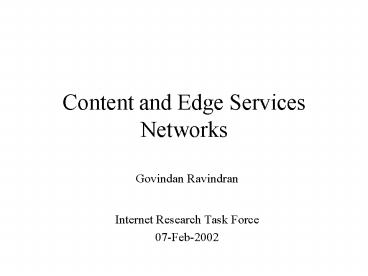Content and Edge Services Networks - PowerPoint PPT Presentation
1 / 29
Title:
Content and Edge Services Networks
Description:
Content and Edge Services Networks. Govindan Ravindran. Internet Research Task Force ... Routing and forwarding of requests and responses for content ... – PowerPoint PPT presentation
Number of Views:101
Avg rating:3.0/5.0
Title: Content and Edge Services Networks
1
Content and Edge Services Networks
- Govindan Ravindran
- Internet Research Task Force
- 07-Feb-2002
2
Overview
- Content Network Overview
- OPES Network
- OPES Service Execution
- ICAP and IRML
- Service Management Issues
- Proposed Work Items
3
What is a Content Network?
Protocols and appliances created exclusively for
the location, download, and usage tracking of
content.
4
Content vs. Traditional Networks
- Network infrastructure that exists in layers 1
through 3 - Routing, forwarding, and switching of frames and
packets - Routers, switches, bridges, etc.
- Network infrastructure that exists in layers 4
through 7 - Routing and forwarding of requests and responses
for content - Caching proxies, surrogates, delegates, etc.
5
Content Network Overlay
Client
Edge Server
Router
Content Overlay Network
Client
Origin Server
Packet Network
Client
6
Types of Content Networks
- Caching Proxies
- Server Farms
- Content Distribution Networks (CDN)
7
Caching Proxies
Requests to Origin Servers
Parent Cache Proxy
Parent Cache Proxy
Requests for a.com
Requests for b.com
Edge Cache Proxy
Content requests
Client
8
Server Farm
Content Server
Content Server
Client A requests
Client B requests
L4-L7 Switch
Content requests
Content requests
Client A
Client B
9
Content Distribution Network
Request Routing System
(1) Content request
(2) Content location
1
2
Surrogate
(3) Content request
3
(4) Content response
4
Client B
10
What is an Edge Services Network?
An overlay infrastructure which extends
content network to operate on and provide a
value-add to the content to be delivered.
11
Edge Services Network Overlay
Client
Intermediary
Edge Server
Router
Client
Edge Services Overlay
Content Network
Origin Server
Packet Network
Client
12
OPES - Example Services
- Virus Scanning
- Location Based Services
- Assembling of Personalized Web pages
- Content Adaptation for Various Client Devices
- Limited Client Bandwidth Adaptation
- Adaptation of Streaming Media
- Request Filtering
- Language Translation
13
OPES - Network Elements
AAA/PDP
Admin Server
Local Exec Environment
Remote Exec Environment
Origin Server
Client
OPES Engine/PEP
OPES Intermediary
Remote Callout Server
14
OPES - Service Execution Points
Admin Server
4
3
Origin Server
Client
Intermediary
1
2
Callout Server
15
OPES Engine
Call-out Protocols (ICAP, HTTP, etc.)
Remote
Remote
Proxylet
Proxylet
Call-out
Call-out
Remote Exec Environment
Local Exec Environment
Proxylet Library
Stub
Stub
Remote Callout
Proxylet
System
Run-time System
Rule Module
Rule Module
Origin Servers
Rule Processor
Clients
Message Parser
OPES Engine
16
Internet Content Adaptation Protocol (ICAP)
- A request/response protocol for executing a
remote procedure call on HTTP messages. - Supports request and response modification.
17
ICAP - Request Modification
6
5
Origin Server
Client
ICAP Client
4
1
2
3
ICAP Server
18
ICAP - Response Modification
6
3
Origin Server
Client
ICAP Client
2
1
4
5
ICAP Server
19
ICAP - Request Modification Example
ICAP Request
REQMOD icap//icap-server.net/server?arg87
ICAP/1.0 Host icap-server.net Encapsulated
req-hdr0, null-body170 GET HTTP/1.1 Host
www.origin-server.com Accept text/html,
text/plain Accept-Encoding compress If-None-Match
xyzzy, r2d2xxxx ICAP/1.0 200 OK Date
Mon, 10 Jan 2000 095521 GMT Server
ICAP-Server-Software/1.0 Connection
close Encapsulated req-hdr0, null-body231 GET
/modified-path HTTP/1.1 Host www.origin-server.co
m Via 1.0 icap-server.net Accept text/html,
text/plain, image/gif Accept-Encoding gzip,
compress If-None-Match xyzzy, r2d2xxxx
ICAP Response
20
Intermediary Rule Mark-up Language (IRML)
- XML-based language used to describe
service-specific execution rules. - IRML rules are processed by rule processors on
Intermediaries. - IRML rules are matched by evaluating rule
conditions against the properties of
incoming/outgoing messages, system and
environment variables.
21
IRML Example
ltrulesetgt ltauthorized-by classcontent-consume
r typeindividualgt ltnamegtA. Becklt/namegt
ltcontactgtlt/contactgt ltidgtlt/idgt
lt/authorized-bygt ltprotocolgtHTTPlt/protocolgt
ltrule processing-point4gt ltproperty
nameContent-Type contextres-msg
matchesdefrgt ltexecutegt
ltservice nameBabelFish Translationgt
lturigtopes//altavista.com/babelfishlt/urigt
lt/servicegt lt/executegt
lt/propertygt lt/rulegt lt/rulesetgt
22
Service Management at Network Edge
- Subscriber Management
- Service Fault Management
- Service Performance Management
- Service Accounting
- Service Alerts and Notifications
- Policy-based Service Management
23
OPES - Subscriber Management
S - Service Execution Point
User Profile includes service subscription,
access rate, device capability, content filters,
etc.
Call-out Server
6
5
7
2
Origin Server
S1
Surrogate
Delegate
9
8
S2
User profile,
Updates
3
4
1
10
Rule Modules
User
PCS Server
Service Manager
Agent
(ICAP Server)
User Profile
(IRML enabled)
24
OPES - Service Authorization
Call-out Server
6
5
7
2
Origin Server
S1
Surrogate
Delegate
9
8
S2
3
4
1
10
User
Service Manager
Agent
(ICAP Server)
25
OPES - Service Fault Management
Call-out Server
Call-out Server
10
9
6
5
11
2
Origin Server
S1
Surrogate
Delegate
13
S2
S2
12
3
8
7
4
1
14
User
Service Manager
Agent
(ICAP Server)
26
OPES - Service Accounting
SDR - Service Detailed Record
Call-out Server
6
5
7
2
Origin Server
Surrogate
Delegate
9
8
User profile,
Updates
3
4
1
10
Accounting Server
User
Service Manager
Agent
(ICAP Server)
SDR
27
OPES - Service Notification
Call-out Server
6
5
7
2
Origin Server
Surrogate
Delegate
9
8
User profile,
Updates
3
4
1
10
Rule Modules
User
Service Manager
Content Provider Service Manager
Agent
(IRML Enabled PEP)
Alerts/ Notification
28
OPES - Server Load Balancing
Call-out Server A
Call-out Server C
Call-out Server B
7
2
Origin Server
Surrogate
Delegate
9
8
3
4
1
10
Call-out servers load and usage statistics
User
Service Manager
Agent
(IRML Enabled PEP)
29
Work Items
- OPES Service Management Informational RFC
- OPES Service Management Framework Definition
- OPES Service Manager Interfaces Definition
- IRML Service Manager Extensions































